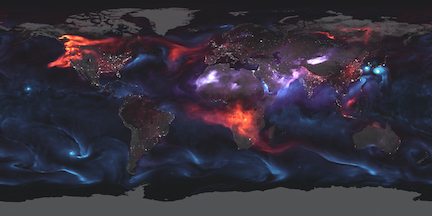 Just Another Day on Aerosol Earth
Just Another Day on Aerosol Earth
(hi-res image here: NASA's Astronomy Photo of the Day)
Model Visualization Credit: NASA Earth Observatory, GEOS FP, Joshua Stevens
It was just another day on aerosol Earth. For August 23, 2018, the identification and distribution of aerosols in the Earth's atmosphere is shown in this dramatic, planet-wide digital visualization. Produced in real time, the Goddard Earth Observing System Forward Processing (GEOS FP) model relies on a combination of Earth-observing satellite and ground-based data to calculate the presence of types of aerosols, tiny solid particles and liquid droplets, as they circulate above the entire planet. This August 23rd model shows black carbon particles in red from combustion processes, like smoke from the fires in the United States and Canada, spreading across large stretches of North America and Africa. Sea salt aerosols are in blue, swirling above threatening typhoons near South Korea and Japan, and the hurricane looming near Hawaii. Dust shown in purple hues is blowing over African and Asian deserts. The location of cities and towns can be found from the concentrations of lights based on satellite image data of the Earth at night.
NASA's Earth Observatory has a page on aerosols, showing optical depth. They have a mov file showing optical depth from 2000 to 2020, with select and compare options. According to the site, "tiny solid and liquid particles suspended in the atmosphere are called aerosols. Windblown dust, sea salts, volcanic ash, smoke from wildfires, and pollution from factories are all examples of aerosols. Depending upon their size, type, and location, aerosols can either cool the surface, or warm it. They can help clouds to form, or they can inhibit cloud formation. And if inhaled, some aerosols can be harmful to people's health."

 Just Another Day on Aerosol Earth
Just Another Day on Aerosol Earth Submission thanks to: TXMX, Josiah, Tiago, LisaRuth, Larry S., Steven Bracco
Submission thanks to: TXMX, Josiah, Tiago, LisaRuth, Larry S., Steven Bracco